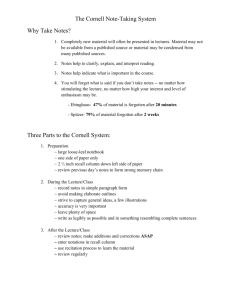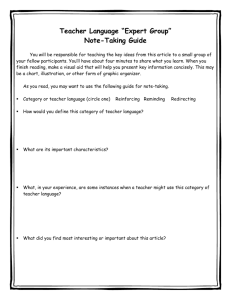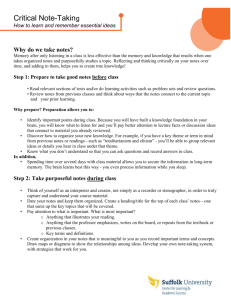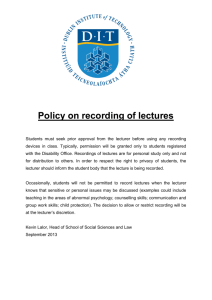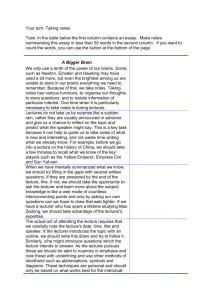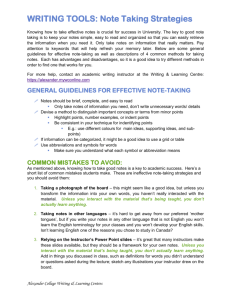D-Note-taking in Lectures - University of St Andrews
advertisement
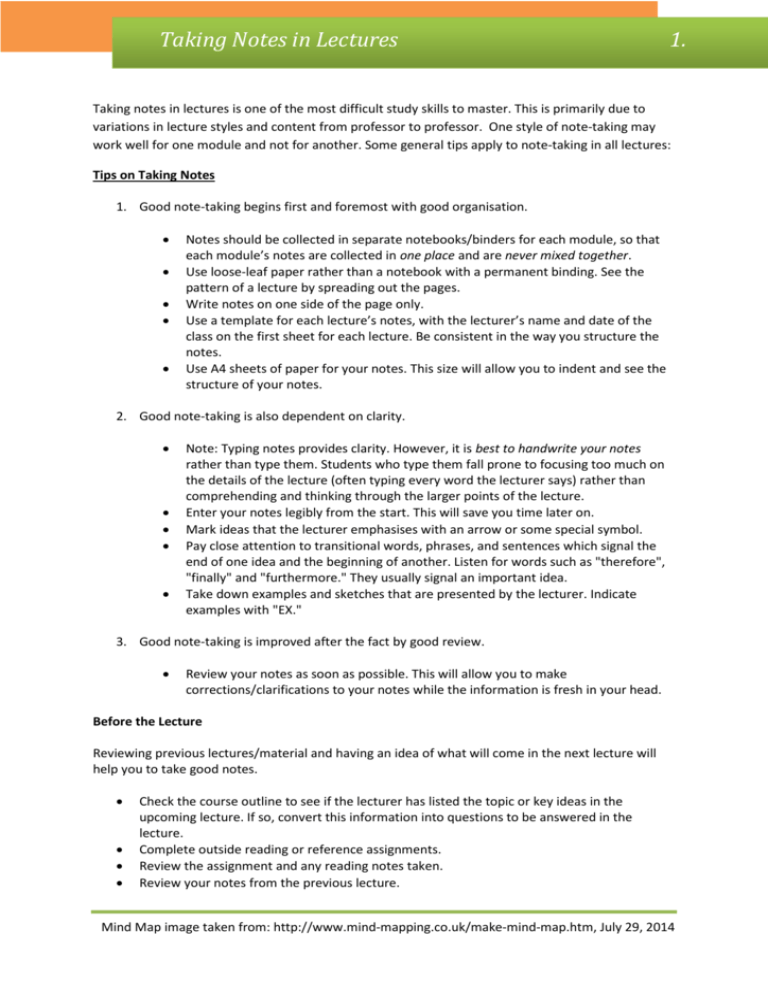
Taking Notes in Lectures 1. Taking notes in lectures is one of the most difficult study skills to master. This is primarily due to variations in lecture styles and content from professor to professor. One style of note-taking may work well for one module and not for another. Some general tips apply to note-taking in all lectures: Tips on Taking Notes 1. Good note-taking begins first and foremost with good organisation. Notes should be collected in separate notebooks/binders for each module, so that each module’s notes are collected in one place and are never mixed together. Use loose-leaf paper rather than a notebook with a permanent binding. See the pattern of a lecture by spreading out the pages. Write notes on one side of the page only. Use a template for each lecture’s notes, with the lecturer’s name and date of the class on the first sheet for each lecture. Be consistent in the way you structure the notes. Use A4 sheets of paper for your notes. This size will allow you to indent and see the structure of your notes. 2. Good note-taking is also dependent on clarity. Note: Typing notes provides clarity. However, it is best to handwrite your notes rather than type them. Students who type them fall prone to focusing too much on the details of the lecture (often typing every word the lecturer says) rather than comprehending and thinking through the larger points of the lecture. Enter your notes legibly from the start. This will save you time later on. Mark ideas that the lecturer emphasises with an arrow or some special symbol. Pay close attention to transitional words, phrases, and sentences which signal the end of one idea and the beginning of another. Listen for words such as "therefore", "finally" and "furthermore." They usually signal an important idea. Take down examples and sketches that are presented by the lecturer. Indicate examples with "EX." 3. Good note-taking is improved after the fact by good review. Review your notes as soon as possible. This will allow you to make corrections/clarifications to your notes while the information is fresh in your head. Before the Lecture Reviewing previous lectures/material and having an idea of what will come in the next lecture will help you to take good notes. Check the course outline to see if the lecturer has listed the topic or key ideas in the upcoming lecture. If so, convert this information into questions to be answered in the lecture. Complete outside reading or reference assignments. Review the assignment and any reading notes taken. Review your notes from the previous lecture. Mind Map image taken from: http://www.mind-mapping.co.uk/make-mind-map.htm, July 29, 2014 Taking Notes in Lectures 2. During the Lecture Write down the title of the lecture, the name of the course and the date. Listen carefully to the introduction (if there is one). Be brief in your note taking. Summarise your notes in your own words, not the lecturer's. Remember: your goal is to understand what he / she is saying, not to try to record exactly everything he / she says. Try to recognise main ideas by signal words that indicate something important is to follow. Examples: "first, second, next, then, thus, another important..." etc. Jot down details or examples that support the main ideas. Give special attention to details not covered in the textbook. If there is a summary at the end of the lecture, pay close attention to it. You can use it to check the organisation of your notes. If your notes seem disorganised, copy down the main points covered in the summary. It will help in revising your notes later. At the end of the lecture, ask questions about points you did not understand. Don't be in a rush. Be attentive, listen and take notes right up to the point at which the lecturer dismisses you. If you are gathering together your personal belongings when you should be listening, you're bound to miss an important point - perhaps an announcement about the next exam or coursework! After the Lecture Revise your notes as quickly as possible, preferably immediately after the lecture since at that time you will still remember a good deal of the lecture. During the first review period after the lecture, co-ordinate reading and lecture notes. Review your lecture notes once a week (see the guide on ‘scheduling’ for how to do this. It is possible!). Review the lecture notes before the next lecture. Note-taking Styles The three most commonly used systems of note-taking are the traditional outline, the Cornell system, and drawing mind maps. Each system has advantages and disadvantages. You as a student must find what works best for you. Outline Creating an outline is the easiest way of taking notes. The advantage of using this method is being able to see the flow of the lecture as it progresses from the first to the last point. The disadvantage of an outline is that it doesn’t allow you to make direct connections between what is said at the start of a lecture with the related information in the middle or end of the lecture. Nor is it possible to highlight key concepts/themes that recur throughout the lecture. Mind Map image taken from: http://www.mind-mapping.co.uk/make-mind-map.htm, July 29, 2014 How to Notes Taking Write in a Lab Lectures Report 1. 3. Cornell Note-taking The Cornell system consists of creating three sections on each Keywords Notes page: approximately a 2” vertical column along the left side of the page, approximately a 6” vertical column on the right side of the page, and an approximately 3” tall horizontal column that runs along the bottom of the page. The left-side column is designated for ‘key words/concepts’ (i.e. 1961 Civil Rights Act). The right-side column is a ‘notes’ section for you to take as you would normally. Remember to write down the key information and not every detail. The horizontal column that spans the bottom of the page is a ‘summary’ section, where you can write Summary a summary of a section or an entire lecture. The advantages of the Cornell system are that key words/concepts/themes can be highlighted and there is a clear start to finish flow of the lecture. The disadvantages of the Cornell system are that it is difficult to link related concepts/themes throughout the lecture. Mind Maps Mind maps are a picture of a lecture. They consist of a lecture title in the centre of a blank page with points and sub-points written around the title. The points and sub-points are connected to each other and to the title by a series of lines. Drawing mind maps of lectures gives the advantage of organising the lecture information on the basis of concepts/themes rather than the flow of the lecture. It also allows the student to engage the creative side of their brain, which, for many students, assists in making sense of the material. The disadvantage of mind maps is that notes can become too-reduced to key words and ideas and, for less visual students, can look more like chaos than organisation. Mind Map image taken from: http://www.mind-mapping.co.uk/make-mind-map.htm, July 29, 2014

